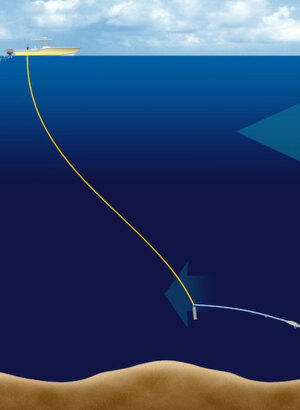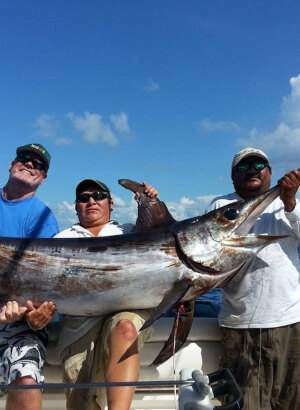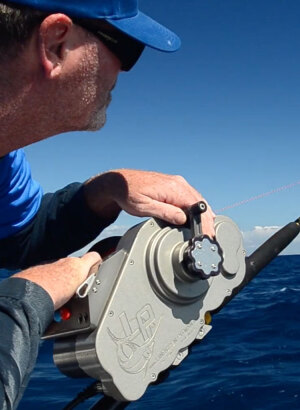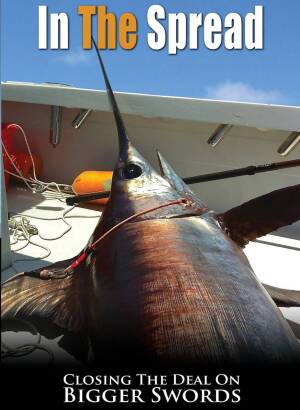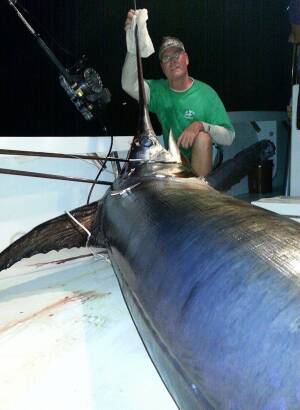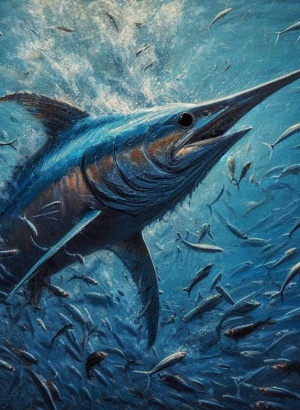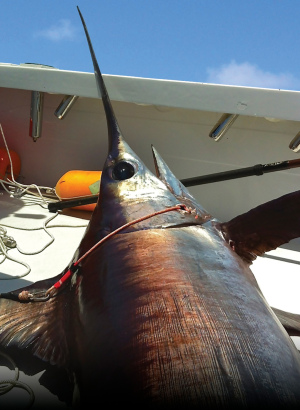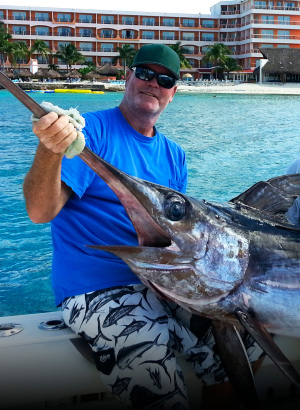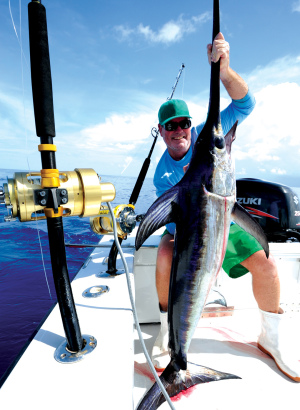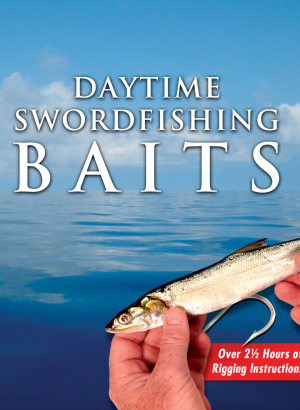Swordfish, also known as Xiphias gladius, are large predatory fish in the Xiphiidae family, weighing over 1,400 pounds and growing up to 14 feet long. They have a distinctive long bill used to stun prey and are found in warm and temperate waters. They feed on squid, mackerel, and other small fish. Swordfishing can be challenging, but understanding fishing techniques is essential. In The Spread Swordfish Fishing Videos provide guidance.

Swordfish - Biology of a Deep Water Predator
The broadbill swordfish, Xiphias gladius, is a magnificent sea creature. It is among the largest bony fishes in the ocean, growing up to 14 feet long and weighing over 1,400 pounds. Its streamlined body with an elongated bill is designed for predation, allowing it to stun prey with swift, powerful jabs. Its smooth, scale-less skin is often gray or brown, and its dense, flavorful meat is prized by anglers.
Inhabiting warm and temperate regions of the Atlantic, Indian, and Pacific Oceans, swordfish are apex predators that feed on squid, mackerel, and other pelagic fishes. Taxonomically, they belong to the Kingdom Animalia, Phylum Chordata, Class Actinopterygii, Order Perciformes, Family Xiphiidae, and Genus Xiphias.
Swordfishing techniques, though intricate, can be mastered with the right knowledge and skills. "In The Spread Swordfish Fishing Videos" provide valuable guidance and expert insights to help anglers succeed in catching these formidable fish.
Features of a Sword
Swordfish have a number of distinguishing features that set them apart from other fish species:
- Long, pointed bill: Perhaps the most distinctive feature of the swordfish is their long, pointed bill, which is used to slash and stun prey. No other fish species has a bill quite like that of the swordfish.
- Forked tail: The deeply forked tail of the swordfish is another unique feature, which helps to give the fish added maneuverability and speed in the water.
- Smooth, scaleless skin: Swordfish have smooth, scaleless skin that is distinctive from the skin of other fish species. Their skin is typically gray or brown in color, and may have a metallic sheen in certain lighting conditions.
- Elongated body shape: Swordfish have an elongated, cylindrical body shape that is well-suited to their predatory lifestyle. Their body is designed for high-speed swimming and powerful strikes, allowing them to quickly overtake and capture their prey.
- Powerful swimming ability: Swordfish are known for their impressive swimming ability, which sets them apart from many other fish species. They are able to swim at incredibly high speeds for sustained periods, allowing them to effectively hunt and capture fast-moving prey.
Overall, the combination of their unique bill, forked tail, smooth skin, elongated body shape, and powerful swimming ability make the swordfish one of the most distinctive and recognizable fish species in the ocean.
Body Color
The predominant colors of swordfish are varying shades of gray, brown, and tan on their dorsal (upper) side. This cryptic countershading allows them to blend in perfectly from above against the muted colors of the ocean depths.
Ventrally (underside), they fade to a much lighter gray or whitish hue. This concealing coloration helps mask their silhouette from below against the faint light filtering down from above.
Their sleek, scaleless skin has a beautiful metallic sheen or iridescent quality when viewed from certain angles. This may help camouflage their movements with shimmering light refractions.
Many individuals also exhibit subtle vertically-oriented stripes, bars, or mottled patterns along their flanks. This "disruptive" patterning breaks up their body outline, providing an additional camo effect.
All of these coloration strategies serve to make swordfish practically invisible as they stealthily stalk their prey. Only their lateral vision betrays their presence at the last second before they strike.
The varied hues and markings of swordfish likely play roles beyond just camouflage as well. They may also aid in species and individual recognition for communication and hierarchical dynamics.
Overall, the paint job of these marine predators highlights nature's nuanced artistry in equipping them as supreme hunters - simultaneously conspicuous and invisible as the situations demand. A perfect blend of form and function.
Body Weight and Size
Swordfish, also known as broadbills, can attain truly massive sizes. Their dimensions span an incredibly wide range, a testament to their apex predator status. Let's take a deeper look at the specifics of their size potential:
On the smaller end of the scale, an average adult swordfish measures around 6.5 to 9.8 feet (2-3 meters) in length and weighs between 120-660 lbs (55-300 kg). These mid-sized specimens are already formidable marine creatures.
However, swordfish have the capacity to reach true giant proportions under optimal conditions. Larger individuals can exceed an enormous 14 feet (4.3 meters) in length - longer than a great white shark! At this leviathan size class, their weights can surpass a staggering 1,400 lbs (635 kg).
Records show the largest swordfish ever caught tipped the scales at a mind-boggling 1,560 lbs (708 kg) and measured nearly 15 feet (4.6 m) from bill to tail! Truly a monster of the deep.
This incredible size range stems from swordfish being among the fastest growing marine species. They bulk up rapidly by capitalizing on abundant food resources across vast oceanic ranges over lifetimes exceeding 10 years.
The ability to attain such colossal sizes cements the swordfish's reputation as one of the most powerful, streamlined predators patrolling the world's temperate and tropical waters. An awe-inspiring example of evolution's propensity for gigantism in the marine realm.
Mouth and Bill Structure
A key anatomical feature that makes the swordfish such a formidable predator is its elongated upper jaw, forming a distinctive "sword" or bill. Let's delve deeper into the specifics and adaptations of this remarkable structure:
The sword can measure up to an impressive one-third of the fish's total body length. In a large adult, this could mean a bill extending over 4 feet (1.2 meters) beyond the mouth! This provides an incredible reach advantage when hunting.
Swordfish employ their bills with lightning-fast speed and precision to slash at and stun prey. The bill's slight flattening and sharp edges make it a highly effective offensive weapon. Many swordfish bills bear scars from epic battles with prey.
Inside the mouth, swordfish possess rows of elongated, razor-sharp teeth. These slender dentitions are perfectly adapted for grasping and securing struggling prey items once stunned or speared by the bill.
The swordfish's entire mouth and head structure is built for high-speed attacks. The streamlined profile reduces drag, while powerful neck muscles generate incredible ramming force. This allows swordfish to overtake fast-swimming pelagic prey.
Amazingly, swordfish can selectively heat their eyes and brain using special organs near the eyes. This "thermal vision" grants them a huge advantage in detecting the heat signatures of prey in deep, cold waters.
The combination of the elongated bill, grasping teeth, and high-speed mouth adaptations make swordfish one of the ocean's most finely-honed predatory machines. A true marvel of evolutionary engineering on a grand scale.
Speed
These oceanic predators are renowned for their speed, power, and endurance in the open water. Let's dive into the specifics of their remarkable locomotion:
Swordfish are built for speed, with a hydrodynamic, streamlined body shape that minimizes drag. Their powerful, crescent-shaped tail fin generates strong propulsion, enabling them to reach bursts of up to 60 miles per hour (97 km/h)! This is faster than the cheetah, the land speed champion.
While these top speeds are impressive, swordfish typically maintain a more sustainable pace of around 30-40 mph (48-64 km/h) when actively foraging. This allows them to cover vast distances efficiently in search of prey.
Their muscular body composition and efficient oxygen exchange system grant them incredible swimming endurance. Swordfish are adapted for long-distance, high-speed pursuits, able to maintain fast cruising speeds for extended periods.
This exceptional swimming performance is key to the swordfish's predatory success. They can rapidly overtake fast-moving prey like squid and pelagic fish, giving little chance of escape. Few marine creatures can outswim a determined swordfish on the hunt.
Swordfish aren't just fast in straight line speed, but also highly maneuverable. Their elongated bill serves as a rudder, enabling rapid directional changes. This agility is a huge advantage when pursuing elusive prey through the complex environment of the open ocean.
The combination of raw speed, sustained endurance, and agile maneuverability makes the swordfish a truly formidable apex predator. Their swimming abilities are a testament to nature's incredible capacity for engineering high-performance animals adapted to life in the fast lane of the marine realm.
Tail
The swordfish's deeply forked tail, or caudal fin, plays a critical role in its remarkable swimming abilities. This specialized structure is a true marvel of evolutionary engineering, perfectly adapted for a life of high-speed pursuit in the open ocean. Let's explore the specifics of how this tail enables such impressive locomotion:
The swordfish's tail is composed of two large, elongated lobes that extend outwards from the base of the caudal peduncle. This deeply forked shape is known as a "lunate" tail, resembling a crescent moon. It's a hallmark adaptation of fast-swimming pelagic predators.
The lobes are made up of incredibly powerful muscular tissue, arranged in a complex layered structure. These muscles are rich in red muscle fibers, providing exceptional strength and endurance for sustained high-speed swimming.
During swimming, the tail lobes move back and forth in a rapid, oscillating motion. This generates immense thrust, propelling the swordfish forward at remarkable speeds. The deeply forked shape maximizes the efficiency of this propulsion, reducing drag and conserving energy.
The caudal fin's streamlined, hydrodynamic profile is key to its performance. The narrow base and wide, sweeping lobes minimize turbulence and cavitation, allowing for smooth, high-speed movement through the water.
In addition to raw power, the forked shape of the tail also provides exceptional maneuverability. By adjusting the angle and sweep of the lobes, swordfish can make lightning-quick directional changes, crucial for pursuing agile prey.
Coloration of the tail is often dark, with distinct patterns or markings that are believed to be unique to each individual. This patterning may aid in communication and recognition between conspecifics.
The swordfish's tail is a true evolutionary wonder, a perfect fusion of form and function. Its specialized structure is the key to this species' incredible swimming performance, enabling them to reign as swift, agile predators of the open ocean. An icon of nature's engineering at its finest.
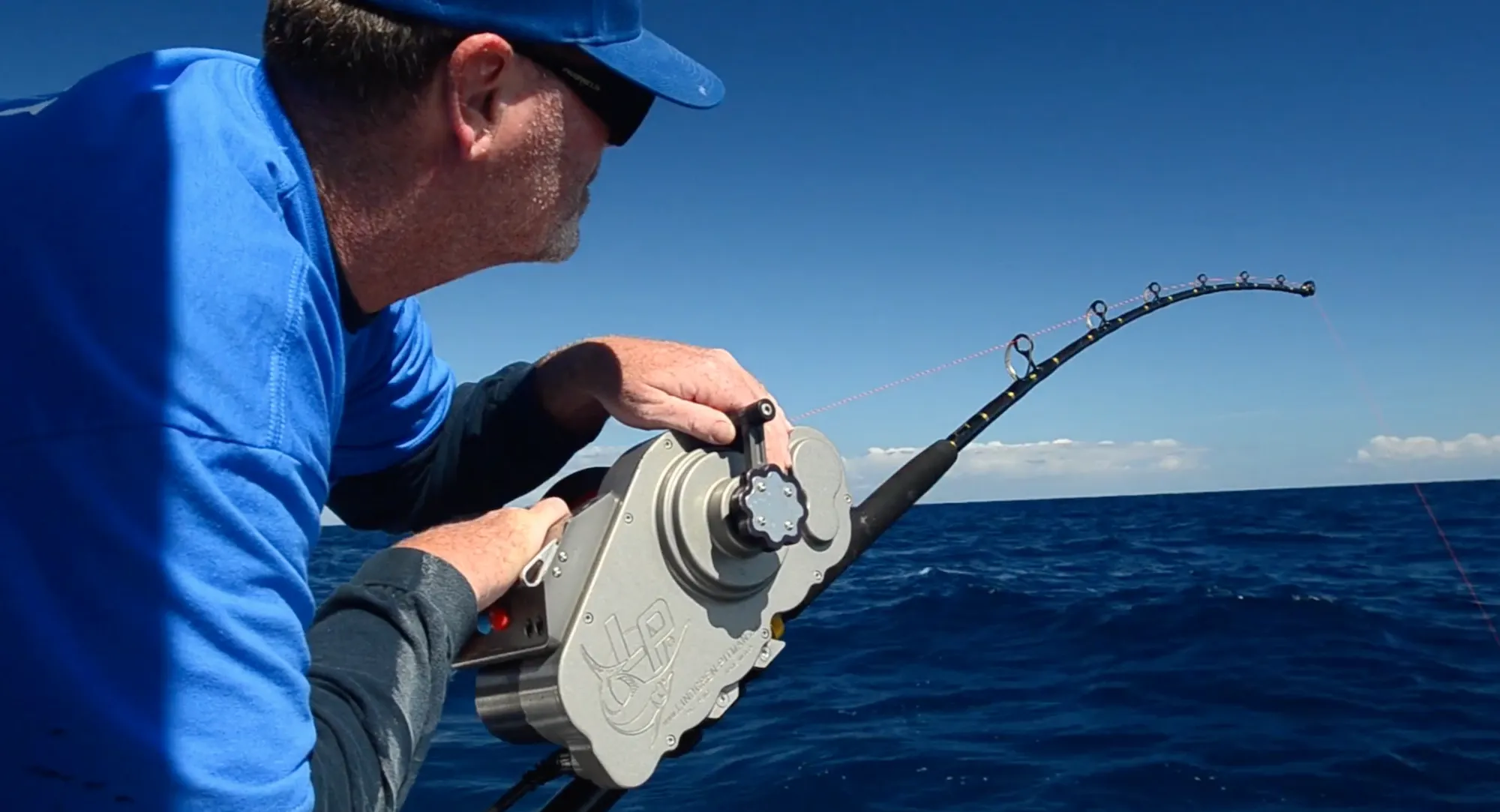
Sporting Quality
Swordfish are considered one of the most prized game fish in the ocean due to their incredible strength, speed, and endurance, making them an exhilarating and challenging catch for anglers of all skill levels. These magnificent creatures are particularly revered for their remarkable fighting ability when hooked, putting up a fierce and prolonged battle that can last for hours as they powerfully attempt to break free.
What makes swordfish even more coveted among sport fishers is their elusiveness and rarity. Found in deep offshore waters, targeting these formidable fish requires dedication, expertise, and a willingness to invest significant time and effort. Specialized gear and techniques are essential to successfully land a swordfish, adding to the thrill and sense of accomplishment for those who pursue them.
The sporting qualities of the swordfish are unmatched. Their size, power, and tenacity create an adrenaline-fueled experience that draws anglers from around the globe. The prospect of hooking into one of these marine giants and engaging in an epic battle of wills is a dream for many fishing enthusiasts. Catching a swordfish is considered the ultimate achievement, a testament to an angler's skills and perseverance.
Beyond the excitement of the catch itself, swordfish also hold culinary value, with their dense, flavourful meat being highly prized in many cuisines. This duality of sporting prowess and gastronomic delight further elevates the swordfish's status as one of the most sought-after and respected game fish species in the world's oceans.
Predatory Instincts
Swordfish are true apex predators of the open ocean, highly adapted for hunting and capturing their prey through an impressive array of predatory characteristics. Their speed, power, and agility make them formidable hunters, capable of effectively pursuing and subduing a diverse range of prey species.
Central to the swordfish's predatory prowess is its iconic elongated bill or "sword" - a biological weapon finely honed for slashing and stunning victims. With the ability to rapidly accelerate, the swordfish can close in on its quarry and deliver devastating blows with its sword, either killing or incapacitating the prey to facilitate capture and consumption. This unique anatomical feature, combined with explosive bursts of speed, allows swordfish to successfully hunt fast and agile creatures like squid and fish.
Beyond their fearsome bill, swordfish possess an array of finely tuned senses that aid in prey detection and tracking. Their large eyes provide excellent binocular vision, while lateral lines along their body detect vibrations and movement in the water, giving them a keen awareness of their surroundings. Their muscular, streamlined bodies are optimized for propulsion, enabling them to swiftly overtake even the swiftest prey.
The swordfish's role as an apex predator is crucial to maintaining the delicate balance of marine ecosystems. Their ability to effectively hunt and subdue a variety of prey species helps regulate populations and ensure the flow of energy through the food web. As such, these remarkable creatures are not only a testament to nature's evolutionary marvels but also integral components of the intricate and interdependent web of oceanic life.
Habitat of Swordfish
Swordfish are pelagic species found in warm and temperate waters globally, inhabiting the Atlantic, Indian, and Pacific Oceans. As true denizens of the open ocean, they typically reside in deep offshore waters far from land.
Remarkably adapted to a wide thermal range, swordfish can tolerate water temperatures from a cool 41°F to a balmy 81°F. They thrive in relatively warm, nutrient-rich waters that foster an abundance of their prey, enabling these apex predators to hunt and flourish effectively.
Migration is an integral part of the swordfish's life strategy. They undergo seasonal movements, traversing vast expanses of ocean in pursuit of prey and optimal environmental conditions. At certain times of year, such as during spawning periods, they may veer towards shallower waters or venture closer to shorelines before returning to their offshore haunts.
The swordfish's habitat is characterized by the vast, nutrient-replete open ocean. These deep pelagic waters teem with the diverse array of prey species that sustain swordfish populations. Finely tuned to thrive in this dynamic marine realm, swordfish are remarkably adapted apex predators that play a pivotal role in oceanic ecosystems worldwide.
Their ability to exploit a broad thermal range and migrate according to shifting prey abundances highlights their evolutionary adaptations for survival in the planet's largest biome. From cool temperate currents to tropical seas, swordfish reign supreme, shaping the intricate web of marine life through their dominant predatory prowess.
Swordfish Distribution
Swordfish boast a remarkably broad distribution spanning warm and temperate waters across multiple oceans and regions worldwide. Their prevalence in these diverse marine environments attests to their adaptability and ecological importance as apex predators. Here are some of the key areas where swordfish are commonly found:
- Atlantic Ocean - These formidable fish inhabit the entirety of the Atlantic, from the Gulf of Mexico and Caribbean Sea to the Mediterranean Sea and West African waters. Their range extends across this vast ocean basin.
- Pacific Ocean - Swordfish populate the Pacific in great numbers, from the waters off the North and South American coasts westward to the seas surrounding Asia and Australia. This ocean's immense expanse provides ample habitat.
- Indian Ocean - The Indian Ocean hosts healthy swordfish populations, with sightings from the East African coastline to the waters near India and Indonesia. Their presence is felt throughout this tropical ocean.
Even the remote Southern Ocean has recorded swordfish visitations, though Antarctica's surrounding frigid waters are not a typical haunt for this warm-water species.
Swordfish distribution is intrinsically tied to the availability of their prey and favorable environmental conditions like water temperature and nutrient levels. They are savvy migrators, seasonally traversing vast distances to exploit productive feeding grounds and optimal spawning areas as these change over time. This behavioral plasticity allows them to dynamically occupy the oceanic regions that best meet their ecological needs.
Swordfish Diet
Swordfish are remarkably opportunistic predators with an incredibly varied diet consisting of a wide range of fish and invertebrate species. As apex predators, their feeding habits play a crucial role in shaping marine ecosystems. Some of their key prey items include:
- Squid - These cephalopods are a primary prey source for swordfish and are believed to make up a substantial portion of their diet. With their speed, agility, and finely tuned senses, swordfish are well-equipped to capture these fast and elusive creatures.
- Other Fish Species - Swordfish prey upon a diverse array of fish, including mackerel, tuna, herring, and sardines. Their explosive acceleration and streamlined bodies allow them to easily overtake and subdue even the swiftest fish.
- Crustaceans - While less common, swordfish will opportunistically feed on crustacean species like krill and shrimp when available.
The swordfish's dietary choices are dictated largely by the localized abundance of potential prey. As consummate opportunists, they readily adapt their feeding strategies to exploit the most readily available resources in their environment. This predatory flexibility is a key reason for their success across vast oceanic expanses.
The varied diet of swordfish highlights their importance as versatile top predators. By regulating populations of squid, fish, and crustaceans, they exert top-down control that reverberates through marine food webs. Their feeding behavior is inextricably linked to maintaining the delicate balance of ocean ecosystems on a global scale.
When and Where to Fish Broadbills
Swordfish can be targeted by anglers in diverse locations worldwide, with the prime fishing grounds and seasons varying based on factors like water temperature, time of year, and local regulations. As a warm-water pelagic species, swordfish are typically found offshore in deep waters ranging from 64°F to 82°F (18°C to 28°C). Some renowned swordfish fishing destinations include:
- Florida - The southeastern U.S. coast, particularly Florida, is a swordfish fishing hotspot. Daytime deep-sea charters are popular here, with many outfitters catering to anglers seeking to battle these mighty fish.
- Mediterranean Sea - The Mediterranean, especially waters off Italy and Spain, provides excellent swordfishing opportunities in this historic fishing region.
- Pacific Ocean - The Pacific yields prime swordfish grounds off the coasts of California and Mexico among other areas.
Timing is critical when pursuing swordfish. Their peak seasons and migration patterns dictate the best fishing periods, which often coincide with warmer summer months when the fish are most active. However, local variables influence these seasonal windows.
In many regions, swordfish fishing adheres to a defined open season regulated to promote sustainable practices. Anglers should thoroughly research these rules and work closely with local charters/guides to plan trips during the permitted timeframes.
Ultimately, targeting swordfish requires carefully considering regional seasonality, migratory behaviors, and fishery management guidelines. Consulting experienced outfitters is invaluable for predicting prime conditions and lawfully intercepting these coveted ocean roamers at the right time and place.
Effective Swordfishing Tips
Swordfish are renowned for being a formidable and elusive quarry that demand specialized tactics from anglers. Successfully landing one of these powerful pelagic predators requires the right gear, strategic bait choices, knowledge of their behavior and haunts, incredible patience, and preparedness for an epic fight. Here are some key tips for effectively targeting swordfish:
- Gear Selection - Proper heavy-duty rods, reels, and line are essential for withstanding a swordfish's power. Invest in equipment specifically engineered for this challenging fishery that can handle their immense size and strength.
- Bait Choices - Swordfish can be notoriously picky eaters. Effective natural baits include oily offerings like squid and mackerel which appeal to their predatory instincts.
- Finding the Fish - As a deep-water species, swordfish typically lurk at depths of 1,000-1,500 feet. Employ depth finders to locate ideal bottom topography and focus efforts on areas with good currents and baitfish activity indicative of their presence.
- Persistence Pays Off - Landing a swordfish often requires an incredible investment of time on the water. Be prepared for multiple hours or even days of dedicated fishing before connecting.
- Capitalize on Nighttime Activity - Many fishermen have found increased success after sundown when these nocturnal hunters tend to be more active near the surface. Specialized deep drop lights on rigs can aid in attracting them.
- Endurance for Battle - Once hooked, swordfish unleash blistering runs and violent headshakes in a powerful fight testing an angler's stamina and resolve. Steeling one's determination is pivotal.
Targeting these marine behemoths demands strategic preparation, local knowledge, cutting-edge gear, and an unwavering commitment from anglers seeking one of sportfishing's most prized trophies. Those who master the intricacies are rewarded with an unparalleled experience.
Instructional Swordfish Fishing Videos
Learn specialized tactics and techniques for swordfishing and make this seemingly difficult fishing endeavor a reality. In The Spread works with the very best to bring you all the information you need to hook this deepwater apex predator. From targeting daytime swordfish to learning how to rig several different baits for swords and learning how to deal with monster swordfish, we have the knowledge you need. Watch Swordfish Fishing Videos and learn.
Fishing Gear
When it comes to swordfishing gear, having the right heavy-duty rods and reels is absolutely crucial for battling these powerful pelagic predators. The demands of this fishery require specialized equipment designed to handle the immense size and strength of swordfish. Here are the specifics on the rods, reels, line and terminal tackle commonly employed:
- Rods: Swordfish rods are extra-long and burly, with lengths of at least 6 feet and line ratings from 50-130+ lbs. The ideal stick can muscle the heavy baits while withstanding a hooked swordfish's blistering runs. Many anglers prefer custom rods engineered specifically for this punishing fishery.
- Reels: Large, stout reels are mandatory, packing high line capacity and smooth, pressure-proof drag systems. Electric reels that can rapidly retrieve explosive runs are very popular, with minimum 500 yard line capacities for braided lines.
- Line: Braided superlines offering extreme strength and minimal stretch are the norm, typically in the 80-130+ lb test range to subdue these brutes. The thin diameter aids casting while the no-stretch properties help maintain solid hooksets.
- Terminal Tackle: This consists of heavy duty swivels, weights to get baits down deep, and stiff 15+ footmonofilament or fluorocarbon leaders to prevent line visibility spooking fish. Each component is overbuilt to handle abusive conditions.
Baits
Selecting the right bait is absolutely critical when targeting the notoriously picky swordfish. These apex predators can be extremely selective, so presenting an enticing and natural-looking offering is key. Some of the most productive and recommended baits include:
- Squid - Perhaps the most popular and effective swordfish bait, squid's oily flesh and erratic movements mimic one of their primary prey items. Proper rigging to create a lifelike presentation is vital.
- Mackerel - The high oil content and strong scent trail of mackerel makes it an excellent swordfish attractor when used alone or combined with squid baits. Its predatory look and lateral movements can trigger explosive strikes.
- Bonito - This small tuna variety is another oil-rich, close relative to mackerel that works well. The shiny sides and energetic baitfish motions appeal to a swordfish's hungry instincts.
- Lures - While less common, some swordfishers do employ large artificial lures like swimming squid imitations oraughta-style skirts. However, these typically see less consistent success compared to natural baits.
Ultimately, having diverse bait options increases chances, as swordfish preferences can be variable day-to-day based on factors like water temperatures and prey concentrations. Experimenting with different combinations and rigging styles is wise until you find what works best for the local conditions. Presenting a lively, enticing offering is pivotal to unlocking a swordfish's notoriously fickle appetites.
Lures
While not as widely used as natural baits, artificial lures can certainly be an effective option for targeting swordfish when employed properly. Some of the more productive lure styles include:
- Skirted Lures: These feature a soft plastic or rubber skirt that undulates enticingly, mimicking the movements of squid or baitfish. Rigged weightednakedhooks allow the addition of natural baits to the lure for an extra attractant.
- Plastic Squid Imitations: Molded soft plastic squid replicas can closely mimic the real thing, both visually and in their swimming action. Rigging with bait enhances the presentation.
- Soft Plastic Baitfish: Large paddle-tail soft plastics can imitate baitfish forage visually and with their kicking tail action. These work well on their own or bait-assisted.
While natural baits remain the go-to for most swordfishermen, lures can be a productive alternate or supplementary option, particularly in low-light conditions. The lifelike movements and profiles can trigger reaction strikes.
As with any lure fishing, proper rigging and presentation are key to selling the illusion. Twitching, swimming, and erratic motions often elevate lure effectiveness. Combining lures with bait can further increase fish-catching potential.
While not the traditional approach, lures do give swordfishers an additional tool in their arsenal to better match the variable preferences of this notoriously fickle gamefish. An open-minded mix of strategies often yields the best results.
Ways to Catch Swords
Swordfish can be targeted both during the day and at night, with tactics tailored for each timeframe's conditions. Here are some of the more productive methods for surface and subsurface swordfishing:
Daytime:
- Deep Dropping - Sending large baits down to hundreds of feet with weight and precise lure movements can entice strikes from swordfish patrolling deep.
- Drift Fishing - Drifting baits or lures at various depths while covering ground can intersect a swordfish's path.
- Surface Casting - Sight casting livebaits or large swimbaits to swordfish basking or finning on the surface allows exciting visual takes.
Nighttime:
- Deep Dropping with Lights - Bright underwater lures attracting baitfish and squid can lure up swords from the depths to feed.
- Drift Fishing with Lightsticks - Drifting livebait rigs or lures illuminated by chemical lightsticks can draw aggressive response.
- Chunking - Dispersing a slick of chopped bait creates an irresistible scent trail that swordfish will follow to the source.
"Run and Gun" - Quickly idling up and pitching baits to the exact position of swordfish finning or tailing on the surface. It requires excellent fish-spotting skills.
Kite Fishing - Using a specialized kite rig to suspend large baits in the uppermost layer where swords may be cruising. Covering water until a fish appears.
While subsurface presentations tend to be more consistent producers, the thrill of teasing up a surface-slashing swordfish is immense for skilled anglers equipped for the challengInge. Proper gear, keen fish-finding tactics, and good timing are key requirements.
Sarah Mendez Especialista de Pesca, In The Spread



